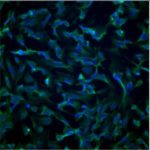Lien vers Pubmed [PMID] – 15766244
Biochemistry 2005 Mar;44(11):4171-80
Topoisomerase I (topo I) is a ubiquitous DNA-cleaving enzyme and an important therapeutic target in cancer chemotherapy. Camptothecins (CPTs) reversibly trap topo I in covalent complex with DNA but exhibit limited sequence preference. The utilization of conjugates such as triplex-forming oligonucleotides (TFOs) to target a medicinal agent (like CPT) to a specific genetic sequence and orientation within the DNA has been accomplished successfully. In this study, different attachment points of the TFO to CPT (including positions 7, 9, 10, and 12) were investigated and our findings confirmed and extended previous conclusions. Interestingly, the conjugates induced specific DNA cleavage by topo I at the triplex site even when poorly active or inactive CPT derivatives were used. This suggests that the positioning of the drug in the cleavage complex by the sequence-specific DNA ligand is able to stabilize the ternary complex, even when important interactions between topo I and CPT are disrupted. Finally, certain TFO-CPT conjugates were able to induce sequence-specific DNA cleavage with the topo I mutants R364H and N722S that are resistant to camptothecin. The TFO-CPT conjugates are thus valuable tools to study the interactions involved in the formation of the ternary complex and also to enlarge the family of compounds that poison topo I. The fact that an inactive CPT analogue can act as a topo I poison when appropriately coupled to a TFO provides a new perspective at the level of drug design.

